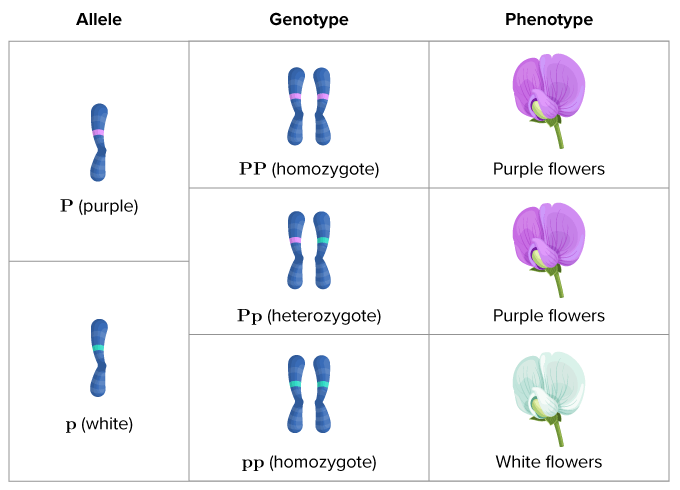3.4 门德尔法
章节大纲
-
What you will learn
::你会学到什么-
The rediscovery of Mendel’s work in the 1900s
::19世纪90年代门德尔作品的重新发现 -
What are the differences between
locus
and
,
genotype
and
phenotype
,
heterozygote
and
homozygote
, and a
dominant allele
and
recessive allele
::病原体与、基因型和苯型、异血体zygote和同系物之间有何区别,以及占支配地位的异系物和隐性异系物之间有何区别?
Do you look like your parents?
::你长得像你父母吗?You probably have some characteristics or traits in common with each of your parents. Mendel's work provided the basis to understand the passing of traits from one generation to the next.
::Mendel的工作为理解这些特征从一代传到下一代提供了基础。Mendel’s Laws and Genetics
::门德尔法律和遗传学You might think that Mendel's discoveries would have made a big impact on science as soon as he made them. But you would be wrong. Why? Because Mendel's work was largely ignored. was far ahead of his time and working from a remote monastery. He had no reputation among the scientific community and no previously published work.
::你可能会认为 孟德尔的发现 会对科学产生巨大影响。 但你会错的。 为什么? 因为孟德尔的工作基本上被忽视了。 孟德尔的工作远比他早得多,并且是在遥远的修道院工作。他在科学界没有名声,以前也没有出版过作品。Mendel’s work, titled in Plant Hybridization , was published in 1866, and sent to prominent libraries in several countries, as well as 133 natural science associations. Mendel himself even sent carefully marked experiment kits to Karl von Nageli, the leading botanist of the day. The result - it was almost completely ignored. Von Nageli instead sent hawkweed seeds to Mendel, which he thought was a better plant for studying heredity . Unfortunately hawkweed reproduces asexually, resulting in genetically identical clones of the parent.
::曼德尔的作品《植物混合》于1866年出版,并被送往几个国家的著名图书馆和133个自然科学协会。 曼德尔本人甚至把精心标记的实验包寄给当年主要植物学家卡尔·冯·纳吉利(Karl von Nageli ) 。 结果几乎被完全忽略了。 冯·纳吉利(Von Nageli)却把鹰毛种子寄给了门德尔(Mendel ) , 他认为这是研究异性学的更好植物。 不幸的是,鹰毛草繁殖了异性生殖,导致母体基因相同的克隆。Charles Darwin published his landmark book on evolution in 1859, not long before Mendel had discovered his laws. Although Darwin continued to refine his theory until his death in 1882, Darwin never learned of Mendel's discoveries and didn’t understand heredity. This made his arguments about evolution less convincing to many people. This example demonstrates the importance for scientists to communicate the results of their investigations
::查尔斯·达尔文在1859年出版了关于进化史的具有里程碑意义的著作,离门德尔发现自己的法律还不远。 虽然达尔文在1882年去世前一直在完善他的理论,但达尔文从未了解门德尔的发现,也不了解异端。 这使得他关于进化的论据对许多人来说不那么令人信服。 这个例子表明了科学家们交流其调查结果的重要性。Rediscovering Mendel’s Work
::重新覆盖门德尔的工作Mendel’s work was virtually unknown until 1900. In that year, three different European scientists — named Hugo De Vries, Carl Correns, and Erich Von Tschermak-Seysenegg — independently arrived at Mendel’s laws. All three had done experiments similar to Mendel’s. They came to the same conclusions that he had drawn almost half a century earlier. Only then was Mendel’s actual work rediscovered.
::孟德尔的工作直到1900年几乎无人知晓。 当年,三位不同的欧洲科学家 — — 名叫Hugo De Vries、Carl Correns和Erich Von Tschermak-Seyseenegg — — 独立抵达门德尔的法律。 这三个人都做了与门德尔相似的实验。 他们得出了他近半个世纪前得出的结论。 直到那时,门德尔的实际工作才被重新发现。As scientists learned more about heredity - the passing of traits from parents to offspring - over the next few decades, they were able to describe Mendel’s ideas about inheritance in terms of genes . In this way, the field of genetics was born.
::随着科学家们更多地了解遗传性 — — 遗传特征从父母传给后代 — — 在未来几十年里,他们能够用基因来描述门德尔关于继承遗产的想法。 这样,遗传学领域就诞生了。Genetics of Inheritance
::继承遗传遗传Today, we know that characteristics of organisms are controlled by genes on (see the Figure ). The position of a gene on a chromosome is called its locus . In sexually reproducing organisms, each individual has two copies of the same gene, as there are two versions of the same chromosome ( homologous chromosomes ). One copy comes from each parent. The gene for a characteristic may have different versions, but the different versions are always at the same locus. The different versions are called alleles . For example, in , there is a purple- flower allele ( P ) and a white-flower allele ( p ). Different alleles account for much of the variation in the characteristics of organisms.
::今天,我们知道生物的特性受基因所控制的(见图 ) 。 染色体上的基因的位置被称为其位置。 在性再生生物中,每个人都有同一基因的两本,因为同一种染色体有两种版本。 一种是来自父母的。 一种特征的基因可能有不同的版本,但不同的版本总是在同一位置。 不同的版本被称为异形。 例如,在性再生生物中,有一个紫花色(P)和一个白花色(P),不同的异形(p)占生物特性差异的很大一部分。Chromosome, Gene, Locus, and Allele. This diagram shows how the concepts of chromosome, gene, locus, and allele are related. What is the difference between a gene and a locus? Between a gene and an allele? During , homologous chromosomes separate and go to different gametes . Thus, the two alleles for each gene also go to different gametes. At the same time, different chromosomes assort independently. As a result, alleles for different genes assort independently as well. In these ways, alleles are shuffled and recombined in each parent’s gametes.
::在此期间,同族染色体分离并转到不同的调子。 因此,每种基因的两种异系元素也都转到不同的调子。 同时,不同的染色体是独立的。 结果,不同基因异系的异系元素也是独立独立的。 在这些方面,异系元素被抖动并重新组合到每个父系的调子中。Genotype and Phenotype
::基因型和基因型When gametes unite during , the resulting zygote inherits two alleles for each gene. One allele comes from each parent. The alleles an individual inherits make up the individual’s genotype . The two alleles may be the same or different. As shown in the Figure , an organism with two alleles of the same type ( PP or pp ) is called a homozygote . An organism with two different alleles ( Pp ) is called a heterozygote . This results in three possible genotypes.
::当调子组合时, 由此产生的zygote 继承了每个基因的两个异变。 一种异变来自每个父母。 一个人的异变组成了个人的基因型。 两种异变可能是相同的或不同的。 如图所示, 两种异变( PP 或 pp) 的有机体被称为同变形。 两种异变( Pp) 的有机体被称为异变形( Pp ) 。 这导致三种可能的基因型 。Relationship between allele, genotype, and phenotype. The expression of an organism’s genotype produces its phenotype . The phenotype refers to the organism’s characteristics, such as purple or white flowers. As you can see from the Figure , different genotypes may produce the same phenotype. For example, PP and Pp genotypes both produce plants with purple flowers. Why does this happen? In a Pp heterozygote, only the P allele is expressed, so the p allele doesn’t influence the phenotype. In general, when only one of two alleles is expressed in the phenotype, the expressed allele is called the dominant allele. The allele that isn’t expressed is called the recessive allele.
::有机体基因型的表达方式产生其苯型。 苯型是指该有机体的特性, 如紫花或白花。 从图中可以看到, 不同的基因型可能产生相同的苯型。 例如, PP 和 Pp 基因型都产生紫色花的植物。 为什么会发生这种情况呢? 在 Pp heterozygote 中, 仅表示Pele, 也就是说, eleetle不会影响苯型。 一般来说, 当两种异类中只有一种以苯型表示时, 表示的异型就被称为占支配地位的异型。 所表述的异型被称作“ 静脉冲 ” 。How Mendel Worked Backward to Get Ahead
::门德尔如何向后工作 向前走Mendel used hundreds or even thousands of pea plants in each experiment he did. Therefore, his results were very close to those you would expect based on the rules of . For example, in one of his first experiments with flower color, there were 929 plants in the F2 generation . Of these, 705 (76 percent) had purple flowers and 224 (24 percent) had white flowers. Thus, Mendel’s results were very close to the 75 percent purple and 25 percent white you would expect by the laws of probability for this type of cross.
::门德尔在每次实验中都使用了数百甚至数千个豆子植物。 因此,他的实验结果非常接近你根据规则所期望的。 比如,在他第一次花色实验中,F2代有929个植物。 其中705个(76%)有紫花,224个(24%)有白花。 因此,门德尔的实验结果非常接近于75%的紫色和25%的白色,而根据这种十字架的概率定律,你将预计到这些植物会达到75%的紫色和25%的白色。Of course, Mendel had only phenotypes to work with. He knew nothing about genes and genotypes. Instead, he had to work backward from phenotypes and their percents in offspring to understand inheritance. From the results of his first set of experiments, Mendel realized that there must be two factors controlling each of the characteristics he studied, with one of the factors being dominant to the other. He also realized that the two factors separate and go to different gametes and later recombine in the offspring. This is an example of Mendel’s good luck. All of the characteristics he studied happened to be inherited in this way.
::当然,Mendel只有同源类型。他对基因和基因类型一无所知。相反,他不得不从同源类型及其在后代中的百分比向后工作,才能理解继承。 从他第一组实验的结果来看,Mendel意识到必须有两个因素来控制他所研究的每一个特征,其中一个因素在另一个因素中占主导地位。他也意识到这两个因素是分开的,去不同的游戏区,然后在后代中再生。这是Mendel好运的一个例子。他所研究的所有特征都是以这种方式继承的。Mendel also was lucky when he did his second set of experiments. He happened to pick characteristics that are inherited independently of one another. We now know that these characteristics are controlled by genes on nonhomologous chromosomes. What if Mendel had studied characteristics controlled by genes on homologous chromosomes? Would they be inherited together? If so, how do you think this would have affected Mendel’s conclusions? Would he have been able to develop his second law of inheritance?
::曼德尔在做第二组实验时也很幸运。 他碰巧选择了相互独立继承的特征。 我们现在知道这些特征是由非异种染色体基因控制的。 如果曼德尔研究了同族染色体基因控制的特征呢?它们会不会被一起继承? 如果是这样,你认为这会如何影响曼德尔的结论?他是否能够制定第二个继承法则呢?DID YOU KNOW? Genes that exhibit incomplete dominance , codominance , or linkage do not follow Mendel's laws of inheritance.
Summary
::摘要-
Mendel’s work was rediscovered in 1900. Soon after that, genes and alleles were discovered. This allowed Mendel’s laws to be stated in terms of the inheritance of alleles.
::1900年,门德尔的作品被重新发现。 不久之后,基因和蛋白被发现。 这使得门德尔的法律可以以阿勒斯的遗产来表述。 -
The gene for a characteristic may have different versions. These different versions of a gene are known as alleles.
::一种特性的基因可能有不同的版本。一种基因的不同版本被称为异形。 -
Alleles for different genes assort independently during meiosis.
::不同基因分布的异象分布 在梅思蒂病期间独立。 -
The alleles an individual inherits make up the individual’s genotype. The individual may be homozygous (two of the same alleles) or heterozygous (two different alleles).
::个人继承的异性构成个人基因型。 个人可以是同性古人(两个同性古人 ) , 也可以是异性古人(两个不同的异性古人 ) 。 -
The expression of an organism’s genotype produces its phenotype.
::生物体基因型的表达方式产生其苯型。 -
When only one of two alleles is expressed, the expressed allele is the dominant allele, and the allele that isn’t expressed is the recessive allele.
::当两个方言中只有一个被表达时,表示的方言是占支配地位的方言,而没有表达的方言是休眠方言。 -
Mendel used the percentage of phenotypes in offspring to understand how characteristics are inherited.
::门德尔利用后代中苯型占的百分比来了解遗传特征的方式。
Review
::回顾-
If Darwin knew of Mendel’s work, how might it have influenced his theory of evolution? Do you think this would have affected how well Darwin’s work was accepted?
::如果达尔文知道门德尔的作品,那会如何影响他的进化理论? 你认为这会影响达尔文的作品被接受的程度吗? -
Explain Mendel’s laws in genetic terms, that is, in terms of chromosomes, genes, and alleles.
::解释Mendel在遗传学方面的法律, 即染色体、基因和蛋白。 -
Explain the relationship between genotype and phenotype. How can one phenotype result from more than one genotype?
::解释基因型和苯型之间的关系。 一个基因型如何从一个以上的基因型中产生?
-
The rediscovery of Mendel’s work in the 1900s


